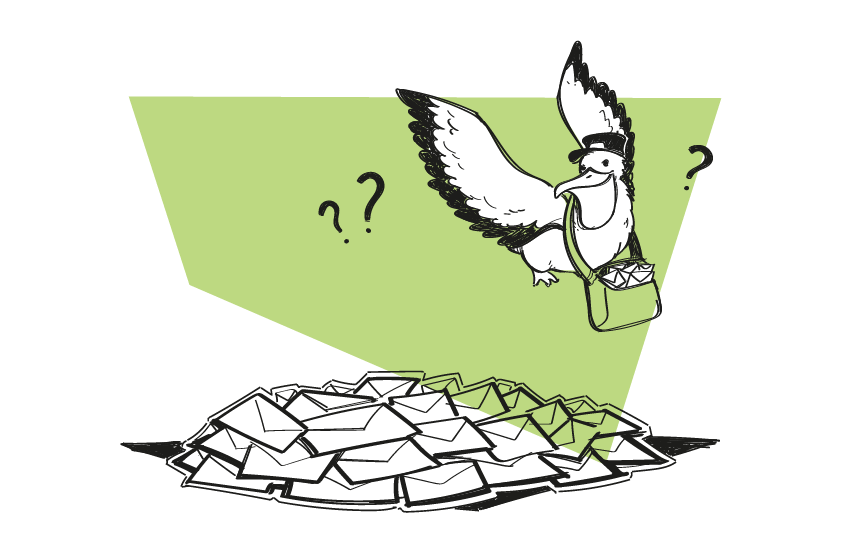You already know that B2B cold emails are a powerful way to move conversations forward quickly, even if they’re starting at zero. And just like any other form of outreach, much of the success of your cold emails depends on how you use that super-short time window to communicate your message.
Every word counts in your cold emails and it’s worth measuring the effect of every one.
That’s why we’ve put together this list of tips and advice for composing your B2B cold emails – ones that work in 2022.
Yup – we talked to Yurii, the head of Business Growth here at Woodpecker, and dug into what’s effective right now.
We’re covering five key areas that can help to make a big difference during the short time you have the prospect’s attention.
1. Relevance & signals
This is a simple yet frequently overlooked way to approach the entire idea behind your cold email pitch — Are you framing everything in terms that speak to the needs and wants of the prospect?
If not, stop and start over again because you’re doing it wrong.
The best copywriters in the business will tell you that relevance is where it all starts and is even more important than personalization in your message.
Who cares if you used someone’s name and made a reference to their work if what you’re offering has zero relevance to what they need?
Your messages need to be hyper-targeted with a laser focus on some challenge the prospect is facing. Again, if this is not the angle you’re taking, stop and start over again because you’re doing it wrong.
Ideally, you’d want to identify the right moment to contact your prospects.
Signals, triggers, intent data – whatever you call it, it’s a game changer.
Here are some ideas on how you can write a B2B cold email using intent data.
Job/role change
Usually, {role} in {industry} I speak with are keenly focused {challenge 1} and {challenge 2} when settling in their role. Curious, does that sound similar to what you’re focusing on at {company}?
Hiring now
So many openings for {position} at your team now, {name}. Maybe I’m way off base here, but I’m guessing that {challenge 1} is a thing. {What you can do to help}. Not sure if {solution to a problem} is a challenge. But if it is, is it worth exploring more?
Reports
Based on X from the report, Y seems to be a goal for {period}. Curious, have you found ways to tackle it?
Tip: if you can’t find this information online, contact someone inside the company (SDR/BDR) and ask them about the main focus right now.
Use that information when getting in touch with the VP/head of the team.
Info found in the comments
(if someone’s active on LinkedIn/Twitter)
{Your comment about} really caught my attention. Is my understanding correct that X and Y are the main challenges?
Funding
After raising {sum} you {name} as {role} of a {industry of company} must be really into {challenge 1} and {challenge 2}. Maybe I’m way off base here, {what you can do to help}. Not even sure if that is the thing for you, but {your best performing CTA}
Website visit
Check tools to see accounts who visited your website, and just send a regular cold email – here’s how to write one.
Event attendance
Attend the actual event and get in touch only with the people who have engaged.
At the event, you mentioned X and Y. Is my understanding correct that A and B are a focus right now?
2. Subject lines
Subject lines are always tricky. If there was a bullet-proof way to write a winning subject line every time, we would all know about it by now.
That just means you need to experiment as much as possible to see what works for you.
Since they are normally the first point of contact with a prospect, subject lines are enormously important. Just because they’re short, don’t think they don’t matter.
Let’s divide our advice on subject lines into “Do’s” and “Don’ts”:
DO
- Keep it short. And not just because you only have a handful of characters. Do both yourself and the prospect a favor and get to the point quickly.
- Have some connection to what’s inside the mail. This may seem like an obvious point but it is often forgotten. Be sure that what the prospect will find inside is an extension of your subject line.
Examples:
Tech stack
Ramping SDRs
One question
Better view
DON’T
- Try to be too creative. This is one of the only times when being creative is a bad thing. Don’t make the mistake of thinking you must have some witty or shocking subject line to get attention. Keep it simple and get to the point (plus, trying too hard can set off the clickbait detector in your prospect and your message won’t even get opened!).
- Attract the attention of spam filters. Here’s another reason to keep it simple and direct. When you try to spice up your subject line with salesy words, excessive punctuation or other “look at me!” elements, you’re potentially crossing the line into spam territory. Avoid cliche marketing tactics and stay on the right side of that line.
3. Preview text
This first visible fragment of your message in recipient inboxes is often called the “most important real estate” in all kinds of marketing because it’s your chance to draw them in further without making them click on the message.
The lesson here is that you shouldn’t waste this space on introductions and pleasantries and instead get to the point.
This is not the time or place for “My name is…”, “I saw…” or “I noticed…”.
Examples:
Usually, new roles in industry have this one challenge that keeps coming up.
Checking your job openings right now.
The preview text is a continuation of your subject line, so use it to get recipients interested enough to open the message to learn more.
4. Problems
Keeping your messaging focused around pain points is a basic in sales generally, not just with B2B cold emails.
This is quite similar to the “Relevance” angle we’ve already covered above but more in line with goals, deadlines and pressures faced by your prospect. Think in terms of “How can I help this person right now?” to get in the right mindset.
Addressing a problem faced by your prospect gets you past the first “Do I really need this?” barrier because, yes, of course they need it. That means you can skip ahead to the next task of convincing the prospect that you’re the person to deliver what they need.
Examples:
Typically with this growth, most Heads of BDR teams in fintech are keenly focused on ramping reps on email so they start delivering in 2-3 months.
Been chatting with a few people in {industry} and this one challenge keeps coming up {challenge}
5. Softer calls to action
Please, please stop asking if you can “schedule a 30-min call this week”!
Yes, getting on the phone is usually the goal but look for other ways to make the invitation without using this line. Instead, try:
- Is this worth exploring on your end?
- Would an email exchange make sense?
- Would it make your event better if you had visual learning aids?
- Would it be helpful to get a more granular look at how your SDRs book meetings via emails?
- I have a (video, ebook, graphic, etc.) that explains this in detail, can I send it?
- Is this among the options you’re looking at right now?
- Have you seen this?
- Maybe I’m way off base here, but is this something you’re also running into?”
- Does that sound similar to your what you’re focusing on at {company}?
Maybe the prospect is ready to chat on the phone and maybe not. If not, don’t ruin your future chances by asking for too much now. Maybe another exchange of emails is what you need to move things forward more slowly.
READ ALSO

How to Write a Cold Email that Actually Works in 6 Steps (2025)
To get replies, a cold email has to be short yet powerful, and intriguing. That's why each part of this short message has to bear meaning and play a crucial communicative role. Check if you know these 6 tremendously important steps to write a cold email for sales that works.

8 Best Cold Email Warm-up Tools in 2025
Have you ever wondered if every email you send from your mailbox will be successfully delivered? If you want to avoid the SPAM folders and land your cold emails in your prospects main inboxes, this article is just for you.

How to Send a Follow-up Email After No Response (2025)
Many cold email senders seem to think that a great opening message is what you need to master the outbound email outreach. Well, it is indeed – but it’s also not enough.

